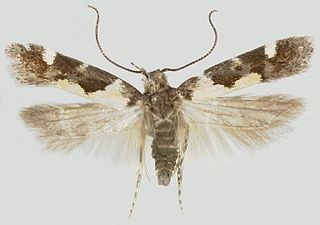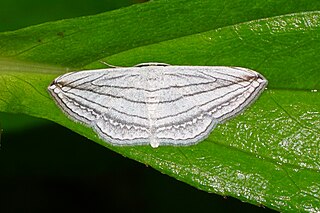
Earias is a genus of moths in the monotypic subfamily Eariadinae of the family Nolidae. The genus was erected by Jacob Hübner in 1825. Species are found throughout Europe, Africa, Asia and Australia, some being agricultural pests such as bollworms.

Stegasta is a genus of moths in the family Gelechiidae.

Pycnarmon is a genus of moths of the family Crambidae described by Julius Lederer in 1863.
Godasa is a monotypic moth genus of the family Noctuidae erected by Francis Walker in 1865. Its only species, Godasa sidae, was first described by Johan Christian Fabricius in 1794. It is found in Cameroon, the Democratic Republic of the Congo, Equatorial Guinea, the Gambia, Ghana, Guinea, Madagascar, Nigeria, Sierra Leone and Tanzania.

Mocis repanda, the striped grass looper, is a species of moth of the family Erebidae. It was described by Johan Christian Fabricius in 1794. It is found in Central America and the Caribbean, including Cuba, the Dominican Republic, Guadeloupe, Guatemala, Jamaica, Puerto Rico and Saint Thomas. Strays can be found in the United States, up to southern Texas as well as subtropical Africa south of the Sahara, including the islands of the Indian Ocean.

Falcatula falcatus is a moth of the family Sphingidae. It is known from savanna and woodland from Zimbabwe to Malawi, Mozambique, Zambia, the Central African Republic and eastern Africa.

Theretra capensis is a moth of the family Sphingidae. It is known from woodland and open habitats from the Cape to Zimbabwe, Zambia, Democratic Republic of the Congo, Malawi, Mozambique and East Africa.

Hodebertia is a genus of micro-moth of the family Crambidae. It contains only one species, Hodebertia testalis, and is found in the tropics, but ranges north to parts of Europe on occasion.

Oraesia emarginata is a species of moth of the family Erebidae first described by Johan Christian Fabricius in 1794. It is found in Australia, New Caledonia, Indonesia, New Guinea, Pakistan, the Philippines, India, Sri Lanka, Sulawesi, Taiwan, China, Japan, Korea and Nepal as well as Eritrea, Ethiopia, Kenya, Namibia, Nigeria, South Africa, Tanzania, the Gambia, Uganda, Oman and Yemen.

Scopula opicata is a moth of the family Geometridae first described by Johan Christian Fabricius in 1798. It is found in tropical Africa, including Malawi and Zambia, as well as in Sri Lanka, India, China (Hainan), Myanmar, Sundaland, the Philippines, Sulawesi, Timor and New Guinea.
Trabala charon is a moth of the family Lasiocampidae, first described by Herbert Druce in 1910. It is found in the Democratic Republic of the Congo, Cameroon, Kenya, Kenya, Malawi, Tanzania, Uganda, Zimbabwe and Zambia.
Parotis marinata is a moth in the family Crambidae. It was described by Johan Christian Fabricius in 1784. It is found in India, Sri Lanka, New Guinea, on the Solomon Islands, the Democratic Republic of the Congo, South Africa. and Australia.
Patania expictalis is a species of moth in the family Crambidae. It was described by Johan Christian Fabricius in 1781. It is found in the Democratic Republic of the Congo and Zambia.
Pycnarmon albivittalis is a moth in the family Crambidae. It was described by George Hampson in 1912. It is found in South Africa.
Pycnarmon sexpunctalis is a moth in the family Crambidae. It was described by George Hampson in 1912. It is found in the Democratic Republic of the Congo (Équateur), Nigeria and Sierra Leone.
Pycnarmon subpictalis is a moth in the family Crambidae. It was described by George Hampson in 1912. It is found in Sierra Leone.

Pycnarmon meritalis is a moth in the family Crambidae. It was described by Francis Walker in 1859. It is found in Democratic Republic of the Congo, South Africa, Australia, China, Sri Lanka, India, Indonesia, Taiwan and Japan.
Pycnarmon diaphana is a moth in the family Crambidae. It was described by Pieter Cramer in 1777. It is found in Cameroon, the Democratic Republic of the Congo, Equatorial Guinea, Ethiopia, Seychelles, Sierra Leone, South Africa, Zambia, Zimbabwe, India and Sri Lanka.









